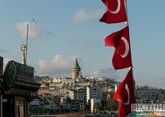The German political scientist, German Council on Foreign Relations (DGAP) associate fellow, specialist in railway and port communications in Eurasia Jacopo Pepe told Vestnik Kavkaza about the prospects for the development of transport infrastructure and its importance for the European Union.
- What is the role of the South Caucasus, in particular Azerbaijan, in Europe's Eurasian transport and infrastructure strategy?
- The European Union does not have a 'Eurasian strategy' as such, at least similar to China's One Belt One Road or the Eurasian Economic Union's strategy with its clear geopolitical and geo-economic orientation. The European Union has several regional instruments, such as the new strategy on Central Asia or the European Neighborhood Policy (ENP), which includes the South Caucasus. The Southern Gas Corridor should be also mentioned here, and well as the fact that the European Union has been pursuing a new transport policy since January 2014, the basis of which is the Trans-European Transport Network (TEN-T.) The new EU transport policy is called 'From West to East in half an hour.'
Meanwhile, we should admit that there is still no clear distinction between geo-economic, geopolitical goals and development goals, just as there is no comprehensive strategic element linking them. The recently released Connectivity Strategy was the first step in the right direction. But this is just a technical document, which has no political component and a clear vision of how the EU interacts with the One Belt One Road initiative, with the Eurasian Economic Union; and how Central Asia and the Caucasus fit into this interaction.
Nevertheless, the Connectivity Strategy captures the EU’s interest in the South Caucasus. It is clear that the Caucasus for the European Union is no longer a periphery or a potential bridge to Central Asia, but a region where interaction and competition with Russian and Chinese infrastructure projects are intensifying. Therefore, the EU plans to expand its TEN-T network to include members of the ENP, in particular, Georgia and Azerbaijan. The European Union recently signed six agreements and began funding the renovation of part of the East-West highway in Georgia, which runs from the Baku port in Alat to Georgia's Poti. Chinese and Japanese financial institutions also fund this project. Azerbaijan, for its part, is undoubtedly an important link in the emerging central intermodal corridor connecting the Caspian Sea and the Black Sea, whose relevance will increase if the EU determines priorities and fund the development of an alternative route to Western China.
- Iran has not abandoned hope to modernize and expand its railway system in order to connect to it the Caspian states - Azerbaijan, Russia and Turkmenistan - as well as to implement the North–South Transport Corridor project. How do you assess the chances of success, taking into account the U.S. sanctions against Iran, especially since Siemens and Switzerland's Stadler Rail AG have already announced they would be leaving the Iranian market?
- Tehran’s international isolation and new U.S. sanctions now reduce the corridor’s appeal to European and Indian freight forwarders and European companies, such as Siemens, which negatively affects the necessary modernization of the Iranian railway system. However, this corridor is of big interest in the long run, since it is the shortest route from Iran to Europe. This corridor connects Europe and Russia with India and Southeast Asia via Iran. In the next two decades both regions will become important economic and industrial engines in Asia. In addition, one should remember that regional supply chains, intra-regional links between India, Bangladesh and Pakistan, as well as between Pakistan and Afghanistan are growing, despite political and economic instability and security threats. Communication will expand to include Central Asia and Iran.
Moreover, Iran is both a competitor and a partner for the Caucasus. Chinese companies are interested in a trans-Iranian route to Turkey and the Middle East, while the North-South project, which includes Azerbaijan, depends on a functioning and well-developed Iranian railway system. If Iran’s sanctions are lifted again, or Europeans and Indians can get around them, then Baku must be prepared to increase the competitiveness of the western Caspian North-South route as compared to the east through Turkmenistan and Kazakhstan. The direct railway between Gorgan, Mashhad and the India-funded port of Chabahar gives Iran a distinct advantage.
- The Caspian region announced another transport project - the Caspian Sea - Black Sea (BSCS) International Transport Corridor. How relevant is it, given the fact that it duplicates Lapis Lazuli and the Trans-Caspian International Transport Corridor and generally fits into China's One Belt One Road?
- A few days ago, Turkmenistan, Romania, Azerbaijan and Georgia established the Caspian Sea - Black Sea (BSCS) International Transport Corridor, which runs between Turkmenistan's Caspian Sea port at Turkmenbashi City and Constanta on Romania's Black Sea coast. The BSCS is not a completely new project, technically it already exists and intersects with the Trans-Caspian corridor and the Lapis Lazuli corridor. However, this new initiative can complement the other two, as it is aimed at improving the coordinated planning and development of the critical section of the other two corridors.
The Trans-Caspian corridor involves the creation of an intermodal corridor connecting Western China with Eastern Europe via the Caspian Sea, the Caucasus and the Black Sea, while Lapis Lazuli is intended to link Europe and India via Turkmenistan and Afghanistan. However, both will require having sufficient infrastructure and customs, coordination and harmonization of tariffs and logistics in order to realize the potential, especially in the Black Sea-Caspian region. Coordination and harmonization of the development of infrastructure, logistics, customs and tariffs in the ports of Romania, Georgia, Azerbaijan and Turkmenistan are necessary. In this sense, the initiative to harmonize transportation between the port of Turkmenbashi, the port of Alat, the deepwater port of Anaklia and the port of Constanta, being designed in Georgia, could be functional for optimizing the Trans-Caspian corridor and the Lyapis-lazuri corridor. Nevertheless, to assess the impact of this initiative, it is extremely important to consider the role of container transit from China or India to Europe or primary exports from Turkmenistan and Azerbaijan to Europe; work towards a sustainable economic corridor to promote the integration of the Caucasus and Central Asia into regional and global supply chains.
- The European Union has traditionally purchased Caspian hydrocarbons. Does the EU prioritize Will an extensive structure of energy supply routes to the region, as well as a link between Europe’s energy systems and the main suppliers in Central Asia, the Middle East and North Africa remain a priority for the EU?
- The EU is very interested in diversifying supply routes, suppliers and energy sources. In this sense, the European Union has done a lot in recent years, increasing its LNG capacity in ports and connecting new pipelines with North Africa, while maintaining a stable level of imports from Russia. Gas will play a crucial role in the future EU strategy, as demand will increase in the coming years. LNG from the U.S., North Africa and the Middle East, as well as Russia's pipeline gas, will create a balanced combination. While subsequent deliveries from Central Asia and the Caucasus will contribute to further diversification.
Much attention is paid to the Southern Gas Corridor. The route has already been partially put into operation, but two important links are still missing: the Italian section of the Trans Adriatic Pipeline (TAP) and the Trans-Caspian Pipeline with Turkmenistan. A big step towards the implementation of this last section was made by signing the Convention on the Caspian Sea. However, there are still legal and political obstacles that must be overcome. Turkmenistan's obligations to China also complicate the situation.
However, the implementation of the Southern Gas Corridor project will not significantly change the balance between the main suppliers of the EU, including Russia, but will undoubtedly provide additional opportunities for diversifying hydrocarbon sources for Europe.










